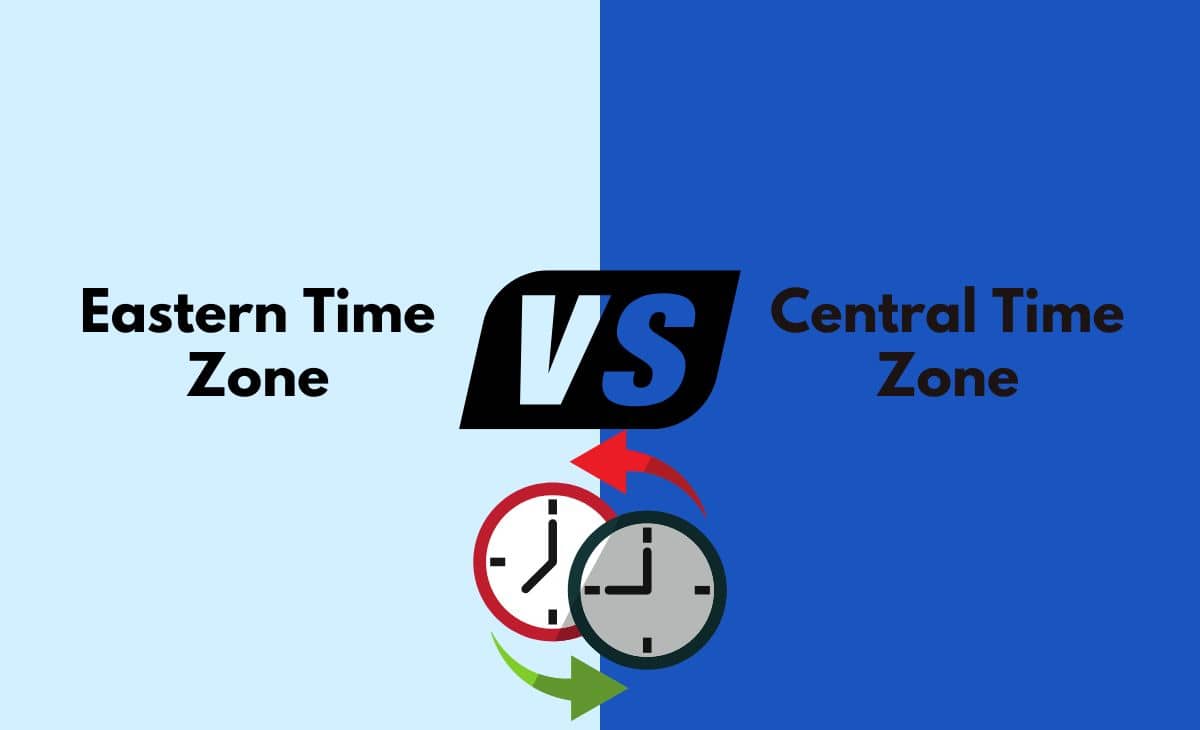Introduction
The Time Zones refer to the standard time of a region or a country. It regulates day and night across the globe.
The world has been divided into 24 time zones, which are based on the number of hours in a day, which means 24 hours in a day. Thus, it indicates that one country has a different time. And each time zone is 15 degrees of longitude. All time zones are defined by their Coordinated Universal Time (UTC), earlier called Greenwich Mean Time (GMT).
In the United States, four main time zones are there, named:
- Eastern time zone
- Central time zone
- Mountain time zone
- Pacific time zone
The Eastern time zone and Central time zone follow daylight savings time (DST). However, despite having few similarities, both the Eastern and Central time zones possess many differences. So, let’s dive into the Eastern and Central Time Zone details.
The Eastern Time Zone vs. Central Time Zone
The Eastern Time Zone or Eastern Standard Time (EST) is the easternmost time zone in the United States. It is also observed in the Caribbean, Central America, and Mexico. The Eastern time zone is five hours behind Coordinated Universal Time (UTC). The Eastern time plays a significant role in commercial and social purposes.
The Central Time Zone or Central Standard Time (CST) is used in North America, Central America, Canada, and Mexico. The Central Time Zone is six hours behind the Coordinated Universal Time (UTC). Central time plays a crucial role in scheduling flights and train departures.
Difference Between The Eastern Time Zone and Central Time Zone in Tabular Form
There are many differences between the Eastern time zone and the Central zone, which were highlighted in a tabular form as follows.
| Eastern Time Zone | Central Time Zone |
| It runs along the eastern seaboard of the United States. | It runs along the left side of Eastern time zone states. |
| The abbreviation of Eastern Time Zone is “EST” or Eastern Standard Time. | The abbreviation of Central Time Zone is “CST” or Central Standard Time. |
| The EST is five hours behind the Coordinated Universal Time. | The CST is six hours behind the Coordinated Universal Time. |
| It lies between 80 degrees west longitude and 90 degrees west longitude. | It lies between 90 degrees west longitude and 105 degrees west longitude. |
| The Eastern Time zone is also referred to as Eastern Time (ET). | The Central Time zone is also referred to as Central Time (CT). |
What is the Eastern Time Zone?
The Eastern time zone is observed in the eastern part of the continent, including 23 states of the United States, parts of Canada, and Mexico. Some Caribbean countries also follow Eastern time, such as the Bahamas and Haiti.
Significance
The Eastern time zone plays a significant role in commercial and social purposes.
Conversion of Eastern Standard Time into Central Standard Time:
The EST is 1 hour ahead of CST, so you have to subtract one hour while converting Eastern Standard Time into Central Standard Time.
What is the Central Time Zone?
It is also known as the Central Plains Time Zone or Central Time. Numerous cities in the United States, including Houston and Chicago, Mexico, lie within the Central time zone.
Significance
The Central time zone plays a crucial role in scheduling flights and train departures.
Conversion of Central Standard Time into Eastern Standard Time:
The CST is 1 hour behind the EST, so you have to add one hour while converting Central Standard Time into Eastern Standard Time.
Main Differences Between The Eastern and Central Time Zone In Points
- The Eastern time zone is one hour ahead of the Central time zone, so the Central time is one hour behind the Eastern time.
- The Eastern time zone affects those states that are parts of Canada and the Caribbean islands (Cuba & Bahamas), whereas the Central time zone affects those states between the Eastern and Mountain time zones and some parts of Canada.
- The Eastern time zone (EST) lies between 80◦-90◦ west longitude, while the Central time zone (CST) lies between 90◦-105◦ west longitude.
- The Eastern Time Zone is also referred to as Eastern Standard Time. The Central Time Zone is also referred to as Central Standard Time.
- The abbreviation of Eastern Time Zone is “EST”, and the abbreviation of Central Time Zone is “CST”.
Conclusion
“Everything in this World works based on their Time Zones.”
Thus, the Eastern time zone and Central time zone work for about 23 states of the United States, including some other countries like Mexico, Canada, and the Caribbean. Both the eastern and central time zones help in determining the standard time of a region or a country. Based on time zones, schedules of flights, train departures, and many other commercial and social activities were decided.

